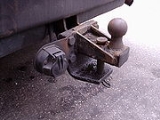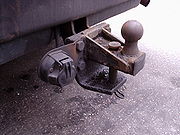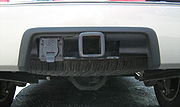
Tow hitch
Encyclopedia

Chassis
A chassis consists of an internal framework that supports a man-made object. It is analogous to an animal's skeleton. An example of a chassis is the underpart of a motor vehicle, consisting of the frame with the wheels and machinery.- Vehicles :In the case of vehicles, the term chassis means the...
of a vehicle for towing
Towing
Towing is the process of pulling or drawing behind a chain, line, bar or some other form of couplings. Towing is most visibly performed by road vehicles, but anything from waterborne vessels to tractors to people can tow cargo. Troop carrying and cargo carrying gliders were towed behind powered...
or a towbar to an aircraft
Aircraft
An aircraft is a vehicle that is able to fly by gaining support from the air, or, in general, the atmosphere of a planet. An aircraft counters the force of gravity by using either static lift or by using the dynamic lift of an airfoil, or in a few cases the downward thrust from jet engines.Although...
nose gear, or paired main gears.
It can take the form of a tow-ball to allow swiveling and articulation of a trailer, or a tow pin
Pin
A pin is a device used for fastening objects or material together.Pin may also refer to:* Award pin, a small piece of metal or plastic with a pin attached given as an award for some achievement...
and jaw
Jaw
The jaw is any opposable articulated structure at the entrance of the mouth, typically used for grasping and manipulating food. The term jaws is also broadly applied to the whole of the structures constituting the vault of the mouth and serving to open and close it and is part of the body plan of...
with a trailer loop—often used for large or agricultural vehicles where slack in the pivot pin allows the same movements. Another category is the towing pintle used on military vehicles worldwide.
Regional variations

North America
In North America the vehicle attachment is known as the trailer hitch. Trailer hitches come in two main configurations: receiver type and fixed-drawbar type. Receiver-type hitches consist of a portion that mounts to the frame of the vehicle that has a rearward-facing opening that accepts removable ball mounts, hitch bike racks, cargo carriers, or other hitch mounted accessories. Fixed-drawbar hitches are typically built as one piece, have an integrated hole for the trailer ball, and are generally not compatible with aftermarket hitch accessories.A trailer hitch typically bolts to the chassis of the vehicle. In North America there are a few common classes: I, II, III, IV, and V that are defined by the SAE.
- Class I —up to 2000 pounds (907.2 kg) — light loads
- Class II —up to 3500 pounds (1,587.6 kg) — light loads
- Class III —up to 5000 pounds (2,268 kg) — larger loads (campers, boats, etc.)
- Class IV —up to 10000 pounds (4,535.9 kg) — larger loads (campers, boats, etc.)
Receiver-type hitches are typically offered with a square receiver opening of 1.25 inches (3.2 cm) (for Class I/II) or 2 inches (5.1 cm) (for Class III/IV/V). Some Class IV/V hitches are available in 2.5 inches (6.4 cm) opening sizes.
The trailer tongue (North America) or coupling (outside North America) slips over a tow-ball. Tow-balls come in various sizes depending on the load they carry and the country of operation: (ISO standard)
In North America, the ball attaches to a ballmount. Receiver-type hitches use removable ball mounts, whereas the fixed drawbar type hitches have integrated ball mounts. The ball mount must match the SAE hitch class. The ballmount for a receiver-type hitch is a rectangular bar that fits into a receiver attached to the vehicle. Removable ball mounts are offered with varying rise or drop to accommodate variations in the height of the vehicle and trailer to provide for level towing.
In order to tow safely the correct combination of vehicle and trailer must be combined with correct loading horizontally and vertically on the tow-ball. Advice should be taken (see references) to avoid problems.
Outside North America, the vehicle mounting for the tow-ball is called the tow-bracket. The mounting points for all recent passenger vehicles are defined by the vehicle manufacturer and the tow-bracket manufacturer must use these mount points and prove the efficacy of their bracket for each vehicle by a full rig-based fatigue test.
Additionally, many pickup trucks come equipped with a 1 to 3 mounting holes placed in the center area of the rear bumper to accommodate the mounting of trailer tow-balls. The ones on the extreme left or right are often used by drivers in rural areas who tow wide farm equipment on 2 lane roads. The far side mounting allows for the item (trailer, etc.) being towed to be further away from the opposite side of the road (on coming traffic, etc.). Caution must be taken when using the bumper of a pickup truck for towing rather than using a frame mounted receiver hitch, as the bumper does not provide for as much strength and therefore is generally used to tow lighter types of loads. Weight ratings for both bumper mounted and frame mounted receiver hitches can be found on bumper of pickup trucks (for bumper mounted trailer tow balls) and on the receiver hitch (for frame mounted receiver hitches). Many pickup trucks without frame mounted receiver hitches often use the rear bumper, especially if the pickup truck is a light duty (not full size) pickup truck.
Europe
In the European UnionEuropean Union
The European Union is an economic and political union of 27 independent member states which are located primarily in Europe. The EU traces its origins from the European Coal and Steel Community and the European Economic Community , formed by six countries in 1958...
, towbars must be a type approved to European Union directive
European Union directive
A directive is a legislative act of the European Union, which requires member states to achieve a particular result without dictating the means of achieving that result. It can be distinguished from regulations which are self-executing and do not require any implementing measures. Directives...
94/20/EC to be fitted to vehicles first registered on or after 1 August 1998.
The ISO standard tow-ball is 50 mm in diameter and conforms to a standard BS AU 113b (replaced by BS ISO 1103:2007). The ISO standard has been adopted in most of the world outside North America.
There are two main categories of ISO tow-ball—the flange fitting and the swan-neck which has an extended neck fitting into the tow-bracket. Swan-neck tow-balls are often removable to avoid the inconvenience of a tow-ball protruding from the vehicle when not required. Some manufacturers are introducing retractable tow-balls as an option.
Across Europe around 25% of vehicles have tow-balls fitted—but there are distinct regional variations, being more common in Benelux and Scandinavia. In Sweden, around 2.2 million cars of around 4.3 million (just over 50%) have tow-balls. In the United Kingdom the popularity of caravans
Travel trailer
A travel trailer or caravan is towed behind a road vehicle to provide a place to sleep which is more comfortable and protected than a tent . It provides the means for people to have their own home on a journey or a vacation, without relying on a motel or hotel, and enables them to stay in places...
is responsible for a high percentage number of 4x4 (SUV) type vehicles being fitted with tow hitches.
Weight-distributing hitch
A weight-distributing hitch is a "load leveling" hitch. It is a hitch setup mounted on the tow vehicle that uses spring bars under tension to distribute part of the trailer's hitch weight from the towing vehicle's rear axle to the towing vehicle's front axle and to the trailer's axle(s). It can help reduce trailer sway and hop. Trailer hop can jerk the tow vehicle. Trailer sway is sometimes called "fish tailing". At high speeds, trailer sway can become dangerous. Most vehicle manufacturers will only allow a maximum trailer capacity of 5000 pounds (2,268 kg) and 500 pounds (226.8 kg) of tongue weight without using a weight-distributing hitch. Tow vehicles often have square receiver sockets to accept weight distributing hitches.Lunette ring
A lunette ring is a type of trailer hitch that works in combination with a pintlePintle
A pintle is a pin or bolt, usually inserted into a gudgeon, which is used as part of a pivot or hinge.A pintle/gudgeon set is used in many spheres, for example: in sailing to hold the rudder onto the boat; in transportation a pincer-type device clamps through a lunette ring on the tongue of a...
hook on the tow vehicle. A pintle hook and lunette ring makes a more secure coupling, desirable on rough terrain, compared to ball-type trailer
Trailer (vehicle)
A trailer is generally an unpowered vehicle pulled by a powered vehicle. Commonly, the term trailer refers to such vehicles used for transport of goods and materials....
hitches.
See also
- CouplingCouplingA coupling is a device used to connect two shafts together at their ends for the purpose of transmitting power. Couplings do not normally allow disconnection of shafts during operation, however there are torque limiting couplings which can slip or disconnect when some torque limit is exceeded.The...
- Fifth wheel couplingFifth wheel couplingThe fifth wheel coupling provides the link between a semi-trailer and the towing truck, tractor unit, leading trailer or dolly. Some recreational vehicles use a fifth wheel configuration, requiring the coupling to be installed in the bed of a pickup truck as a towing vehicle...
- Tow truckTow truckA tow truck is a vehicle used to transport motor vehicles to another location , or to recover vehicles which are no longer on a drivable surface.Towing services are generally provided by an emergency road service operator...
- TractorTractorA tractor is a vehicle specifically designed to deliver a high tractive effort at slow speeds, for the purposes of hauling a trailer or machinery used in agriculture or construction...
- Tractor unitTractor unitA tractor unit, prime mover , road tractor, or traction unit is a heavy-duty commercial vehicle within the large goods vehicle category, usually with a large displacement diesel engine, and several axles. The tractor unit serves as a method of moving trailers...
- TrailerTrailer (vehicle)A trailer is generally an unpowered vehicle pulled by a powered vehicle. Commonly, the term trailer refers to such vehicles used for transport of goods and materials....
- Trailer brake controllerTrailer Brake ControllerA brake controller is usually an oem or aftermarket installed device or module. It is mounted to the tow vehicle's drivers side dashboard area that engages a trailer’s braking system time delayed or proportional to the tow vehicle's brake engagement when slowing down or coming to a halt...
- Trailer Stability ProgramTrailer Stability ProgramTrailer Stability Program, or TSP, is an extension of the car safety system known as Electronic Stability Control, or ESC. It applies exclusively to trailers and caravans...

